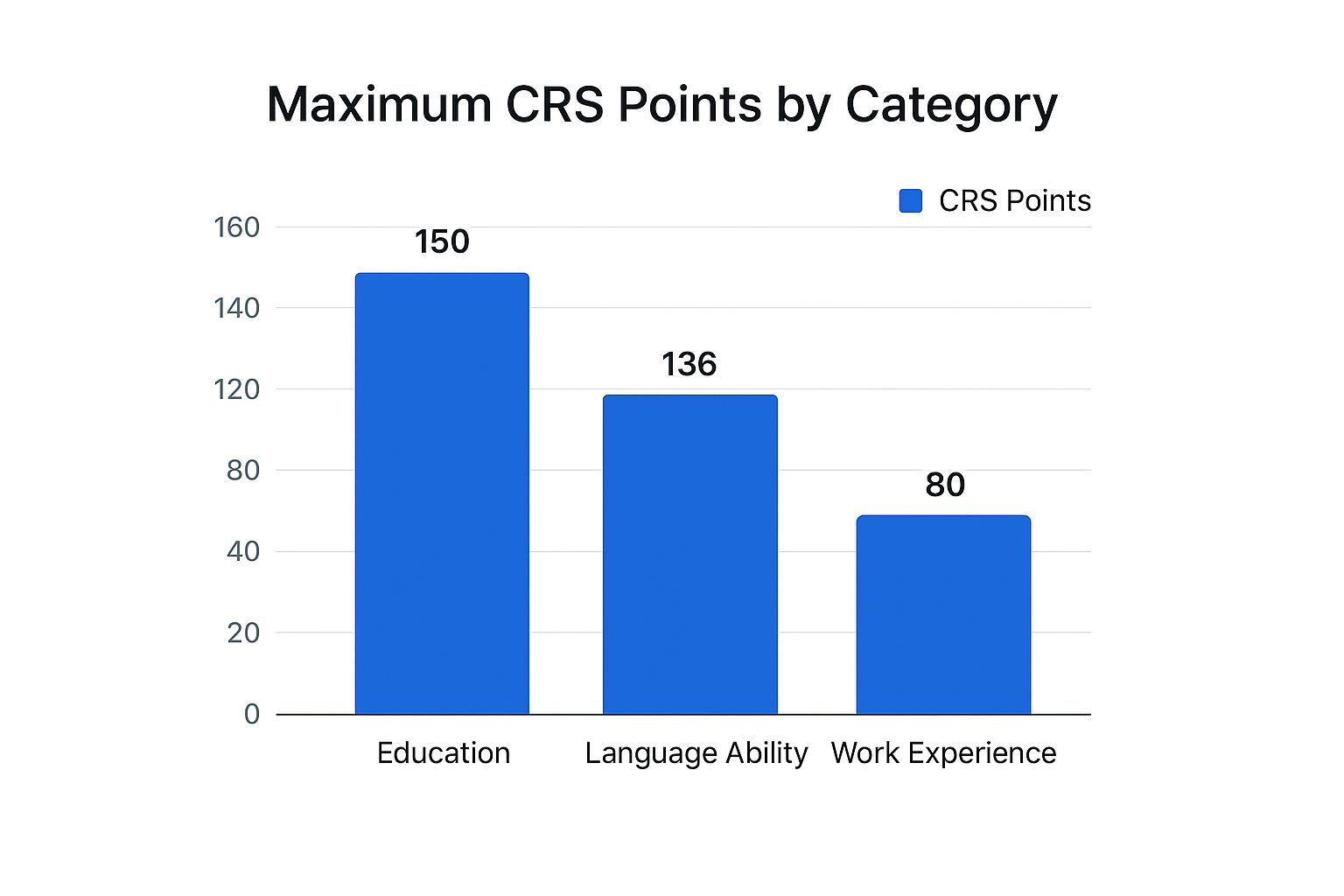Express Entry Calculator: Boost Your CRS Score Today

Decoding Your Express Entry Calculator Results
Understanding your Express Entry calculator results is a critical step for Nigerians hoping to immigrate to Canada. The Comprehensive Ranking System (CRS) is a complex system that evaluates your profile based on several factors, assigning points that determine your ranking in the Express Entry pool. This score is the deciding factor in whether you receive an Invitation to Apply (ITA) for permanent residency.
Understanding the CRS Score Breakdown
The CRS score is calculated across several categories, each with a different maximum point allocation. These categories consider factors such as your education, language proficiency, and work experience. The infographic below visualizes the potential maximum points available in three core categories.

As shown, education offers the most potential points (150), followed by language ability (136) and work experience (80). Optimizing your scores in these areas is vital for a competitive CRS score. Other factors, including age, adaptability, and spousal status, also contribute to your overall score. To understand this in more detail, let’s take a look at the following table:
To help you grasp the scoring potential within the Express Entry system, we’ve prepared a detailed breakdown. This table outlines the maximum points possible for each factor category, crucial requirements for those points, and actionable tips for optimizing your score.
| Factor Category | Maximum Points | Key Requirements | Optimization Tips |
|---|---|---|---|
| Education | 150 | Credential recognized by Canada, ECA report | Pursue higher education levels (Master’s, PhD) |
| Language Ability | 136 | High scores in approved language tests (IELTS, CELPIP) | Aim for CLB 9 or higher in all four language abilities (reading, writing, listening, and speaking) |
| Work Experience | 80 | Skilled work experience within the last 10 years | Gain more years of skilled work experience |
| Age | 110 | Being within the ideal age range (20-29) | N/A |
| Arranged Employment | 100 | Valid job offer from a Canadian employer, LMIA (in most cases) | Secure a job offer in Canada |
| Provincial Nomination | 600 | Nomination from a Canadian province or territory | Apply for relevant Provincial Nominee Programs (PNPs) |
| Adaptability (Spouse/Common-law factors) | 100 | Spouse’s education, language skills, Canadian work experience | Improve spouse’s language scores and education credentials |
This table clearly highlights the significant impact of education, language proficiency, and work experience on your overall CRS score. Strategic planning and maximizing your potential in these areas will be crucial for your success.
How the Express Entry Calculator Works
The Express Entry calculator assigns points based on the information you enter about your profile. Higher education and language proficiency typically result in higher points. A valid job offer or a provincial nomination can significantly boost your CRS score, demonstrating a strong connection to the Canadian job market and enhancing your chances of successful integration.
The Express Entry system manages skilled immigration through various programs, and the CRS is central to this process. In 2025, CRS scores for invitations varied considerably. For example, a Canadian Experience Class (CEC) draw on May 13, 2025, required a CRS score of 547, the highest for CEC draws that year. Learn more about Express Entry rounds of invitations here.
Interpreting Your Results
Your Express Entry calculator result provides a CRS score, but it’s essential to remember that this score is not fixed. You can improve it by enhancing different aspects of your profile. Even if your initial score is lower than desired, opportunities exist to increase it. Improving your language skills or obtaining additional educational qualifications can positively impact your CRS score.
Understanding the factors that influence your CRS score is vital for strategic immigration planning. By focusing on areas where you can gain the most points, you increase your chances of receiving an ITA and realizing your dream of living in Canada. This requires a proactive approach to profile enhancement, considering draw trends and program-specific requirements.
How Recent System Changes Impact Your Calculator Strategy

The Express Entry system has undergone significant changes. Understanding these changes is now essential for calculating your Comprehensive Ranking System (CRS) score and planning your immigration journey. Relying on old information can lead to an inaccurate view of your competitiveness. Let’s explore how these changes are impacting Express Entry strategies, particularly for those from Nigeria.
The Shift From All-Program Draws to Targeted Selection
Previously, all-program draws were the standard, inviting candidates from various programs based on CRS scores. This has changed substantially in 2025. There haven’t been any all-program draws. Instead, Immigration, Refugees and Citizenship Canada (IRCC) has shifted focus.
This focus is now on occupation-specific draws, Provincial Nominee Program (PNP) draws, Canadian Experience Class (CEC) draws, and draws targeting French language proficiency. Learn more about these changes here. This new approach highlights the need to understand program requirements and adapt your strategy.
The Rise of Occupation-Specific Draws
With the rise of occupation-specific draws, the demand for certain professions has increased. Healthcare professionals, tech workers, and skilled tradespeople may find themselves with a distinct advantage. This underscores the importance of researching in-demand occupations in Canada. Aligning your skills and experience with these in-demand areas is crucial.
French Language Proficiency and Provincial Nominations: Two Powerful Boosters
French language proficiency can significantly boost your CRS score. Even moderate French skills can improve your chances of receiving an Invitation to Apply (ITA), especially in predominantly French-speaking provinces. PNPs also remain a strong pathway to permanent residency. A PNP nomination adds 600 points to your CRS score, essentially guaranteeing an ITA. You may also find this helpful: How to master your Proof of Funds for Canada.
Adapting Your Express Entry Calculator Strategy
These changes require a more strategic approach to using the Express Entry calculator. Simply inputting your information is no longer enough. You must factor in the specific requirements of targeted draws, the benefits of French language skills, and the potential of a PNP nomination. This also means researching different PNP streams and their eligibility criteria.
Looking Ahead: Future-Proofing Your Immigration Plans
Staying informed about these trends is critical for future-proofing your immigration plans. While current draw patterns offer insights, it’s important to be aware of possible policy updates and job market changes. This proactive approach helps you adapt your strategy and improve your chances of success within the dynamic Express Entry system. By aligning your skills with Canada’s needs and taking advantage of opportunities like French language proficiency and PNPs, you can significantly strengthen your immigration prospects.
Proven Strategies to Boost Your Calculator Score Fast
Want to take your Express Entry Comprehensive Ranking System (CRS) score to the next level? This section explores proven strategies used by successful applicants from Nigeria. We’ll cover optimizing your language test performance, strategizing your Educational Credential Assessment (ECA), and examining the advantages of Canadian work experience.
Maximizing Your Language Test Scores
Your language test scores (IELTS or CELPIP) significantly impact your CRS score. Even a small improvement can make a difference. Strong language skills, reflected in higher Canadian Language Benchmark (CLB) levels, translate directly into more points. For instance, aiming for CLB 9 or higher can substantially increase your score. Focus on all four areas: reading, writing, listening, and speaking. Consistent practice and targeted preparation are crucial. Resources like dedicated language courses and practice tests can be invaluable. For a deeper dive into calculating your points, check out this resource: How to master calculating your Canada PR points.
Strategic Educational Credential Assessments
Your ECA demonstrates the Canadian equivalent of your Nigerian education. Think of it as translating your qualifications into the Canadian system. Be sure to select a designated organization for your assessment and familiarize yourself with the specific requirements. Having your credentials accurately assessed is essential for maximizing your points. Pursuing further education, such as a Master’s or PhD, can also boost your score.
The Power of Canadian Work Experience
Canadian work experience is a significant asset in your application. It’s like a fast-track towards permanent residency. Even a single year of skilled work in Canada can considerably raise your CRS score and potentially qualify you for programs like the Canadian Experience Class (CEC). Networking in your profession and exploring job opportunities in Canada can help you secure this valuable experience.
Prioritizing Your Efforts for Maximum Impact
Improving your language proficiency is often the quickest and most cost-effective way to improve your CRS score. Gaining Canadian work experience, while highly beneficial, can take more time and resources. Consider your individual circumstances and long-term immigration goals when deciding which areas to prioritize. Also, think about the timelines involved. Improving language scores might take a few months of focused effort, while earning a higher degree or accumulating significant Canadian work experience could take years.
By carefully evaluating these strategies and focusing your efforts, you can effectively boost your CRS score and increase your chances of receiving an Invitation to Apply (ITA).
Understanding Immigration Targets and Draw Patterns

Using an express entry calculator is helpful, but it’s just one factor to consider. To truly understand your Express Entry prospects, you need a broader perspective on Canada’s immigration system. This includes understanding Canada’s immigration targets and their effects on draw sizes, frequency, and the required scores.
How Immigration Targets Affect Express Entry Draws
Canada sets annual immigration targets, impacting the Express Entry system. These targets determine the number of immigrants Canada plans to welcome each year. The number of Invitations to Apply (ITAs) issued through Express Entry draws is directly related to these targets.
A higher target typically means more ITAs and more frequent draws. Lower targets can result in fewer ITAs and potentially higher Comprehensive Ranking System (CRS) requirements.
Canada’s immigration targets for the 2025-2027 period have been adjusted. The target is set to decrease from 395,000 in 2025 to 365,000 in 2027. This shift has influenced draw patterns. Smaller draws are now more common, with higher minimum CRS scores for invitations.
This is especially apparent in Provincial Nominee Program (PNP) draws. PNP draws often have CRS scores exceeding 700. For more information, refer to the official statistics here. This underscores the competitive nature of Express Entry and the importance of a strong CRS score.
Decoding Draw Patterns
Looking at past Express Entry draws offers valuable insights into trends. Analyzing factors like draw frequency, number of ITAs issued, and minimum CRS scores helps understand the system’s dynamics.
For example, a consistent trend of smaller draws and high CRS cut-offs suggests increased competition. Analyzing these patterns helps you manage expectations based on your CRS score and adjust your immigration strategy accordingly.
Program-Specific Draw Trends
Express Entry draws are categorized by specific programs. These include the Federal Skilled Worker Program (FSWP), the Canadian Experience Class (CEC), and the Federal Skilled Trades Program (FSTP).
Each program can have distinct draw patterns and CRS score trends. Targeted draws focusing on specific occupations or skills also influence the overall dynamics. Understanding these program-specific trends is vital for effective Express Entry planning.
Predicting Future Trends and Timing Your Application
While predicting the future is impossible, analyzing draw patterns and considering Canada’s immigration targets provides valuable context. This can assist in strategically timing your Express Entry application.
If you anticipate larger draws or lower CRS requirements, delaying your application might be beneficial. Conversely, a highly competitive environment may make it advantageous to apply as early as possible. Understanding these factors can significantly impact your immigration journey.
Choosing Calculator Tools That Actually Work
Using an Express Entry calculator is a crucial first step for Nigerians planning their move to Canada. However, not all calculators are created equal. Choosing the wrong tool can derail your plans by providing inaccurate Comprehensive Ranking System (CRS) score estimates. This section helps you navigate the different calculators available, from the official government tool to third-party options.
The Official Government Calculator: Your Baseline
The official IRCC (Immigration, Refugees and Citizenship Canada) Express Entry calculator is your starting point. It uses the current points system, ensuring accuracy. Think of it as your baseline measurement. However, it only provides a snapshot of your current eligibility and doesn’t offer scenario planning.
Third-Party Calculators: Exploring “What Ifs”
Several reputable third-party websites offer Express Entry calculators. These can be helpful for exploring different scenarios. For instance, you can see how improving your IELTS score or gaining another year of work experience might affect your CRS score. However, their accuracy depends on how up-to-date they are with the latest immigration rules.
Comparing Calculators: A Table of Key Features
To help you choose the right tool, we’ve compiled a comparison of popular Express Entry calculators. This table highlights their key features, accuracy, and best use cases.
| Calculator Tool | Accuracy Level | Key Features | Best For | Cost |
|---|---|---|---|---|
| IRCC Calculator | Highest | Uses current points system | Baseline assessment | Free |
| JapaChat Calculator | High | Scenario planning, personalized advice | Exploring options | Free |
| Other Reputable Calculators | Varies | Often include additional resources and information | Comparing results | Free |
This table provides a quick overview of the available options, allowing you to select a calculator that aligns with your specific needs.
Understanding Limitations and Margins of Error
It’s important to recognize that all Express Entry calculators have limitations. They provide estimates, not guarantees. Think of your CRS score as a range, not a fixed number. Changes in immigration policies, draw trends, and even minor errors in your entered information can affect the final outcome.
Cross-Referencing and Scenario Planning: Your Path to Success
The best approach is to use multiple reputable calculators and compare the results. This helps you understand potential margins of error and gain a more realistic picture of your competitiveness. Additionally, explore various “what-if” scenarios.
- What if you improve your French language skills?
- What if you get a provincial nomination?
This strategic planning is essential for making informed decisions about your immigration journey. Using the calculator effectively involves much more than simply inputting information. It’s about using that information strategically to plot a course for success.
Why Using the Current Point System Is Crucial
Using an outdated calculator can lead to significant miscalculations. Immigration rules and point systems can change. Imagine using a calculator from 2022—it wouldn’t reflect the targeted draws and other changes that now dominate the Express Entry system. Ensuring your calculator is based on the latest information is essential for accurate planning. For example, many Provincial Nominee Program (PNP) draws now require exceptionally high CRS scores, often above 700. An old calculator wouldn’t account for this change.
Advanced Features to Look For
While the basic CRS calculation is vital, some calculators provide more advanced features. Look for tools that offer:
- Scenario Planning: This lets you adjust different factors (like language scores or work experience) and see how they impact your potential CRS score.
- Program-Specific Calculations: Some calculators allow you to calculate scores based on the specific requirements of different programs (Federal Skilled Worker Program (FSWP), Canadian Experience Class (CEC), Federal Skilled Trades Program (FSTP)).
- Provincial Nomination Information: Tools that integrate information about PNPs can be invaluable. These help you explore potential pathways to increase your CRS score significantly.
These features can make a substantial difference in your planning and decision-making process.
Building Your Personal Immigration Action Plan

Now that you have a better understanding of your Express Entry Calculator results and the Canadian immigration system, it’s time to develop a personalized action plan. This plan will be your roadmap to maximizing your Comprehensive Ranking System (CRS) score and reaching your Canadian immigration objectives.
Setting Achievable Timelines and Prioritizing Enhancements
First, establish a realistic timeframe for your immigration journey. Consider the time needed for language training, credential assessments, and collecting all the required documentation. Once you have a general timeline, prioritize the improvements that will have the greatest positive effect on your CRS score. For example, if your language scores are low, improving them might be a more efficient way to boost your score than pursuing further education.
Creating a Detailed Action Plan with Specific Steps
Your action plan should outline specific, measurable steps with clear timelines and milestones. Here’s a potential framework:
Language Training: Create a study schedule, consider enrolling in a language course (IELTS or CELPIP), and establish target scores for your chosen test. Aim for CLB 9 or higher for the best possible score.
Credential Assessment: Select a designated organization for your Educational Credential Assessment (ECA). Compile the necessary documents and submit your application. Be sure to track the processing time and incorporate it into your overall timeline.
Work Experience: If you are aiming for Canadian work experience, research relevant job opportunities in your field. Networking with professionals in Canada and exploring job boards can be very helpful.
Provincial Nomination: Research the different Provincial Nominee Programs (PNPs) and their eligibility criteria. Focus on programs that align with your skills and experience, and start preparing your application materials. For example, you might find this helpful: How to master Manitoba PNP.
Building Backup Plans for Different Scenarios
It’s important to develop contingency plans. What happens if your language test scores aren’t what you hoped for? What if you are not selected for a provincial nomination? Having alternative strategies in place allows you to remain flexible and maintain momentum throughout the process.
Tracking Progress, Celebrating Milestones, and Staying Motivated
Use a tool, such as a spreadsheet, to track your progress and celebrate your accomplishments. This can help you stay organized and motivated, particularly during the often lengthy immigration process.
Adapting to System Changes and New Opportunities
The Canadian immigration system is constantly changing. Stay up-to-date on changes to Express Entry rules, draw patterns, and program requirements. Be ready to adjust your action plan to take advantage of any new opportunities that arise.
Maintaining Motivation and Adaptability
The immigration process can be demanding. Building a support network, connecting with other applicants, and consulting with immigration professionals can provide valuable support and help you stay focused on your goals. Remember to acknowledge your achievements and stay resilient when facing challenges.
Ready to take charge of your Canadian immigration journey? JapaChat, Nigeria’s AI immigration expert platform, can assist you. We provide personalized guidance, current information, and interactive support to help you at each stage. From visa requirements to travel logistics, JapaChat offers the clarity and confidence you need to pursue your international aspirations. Sign up for free today and learn how JapaChat can simplify your relocation: JapaChat

Leave a Reply